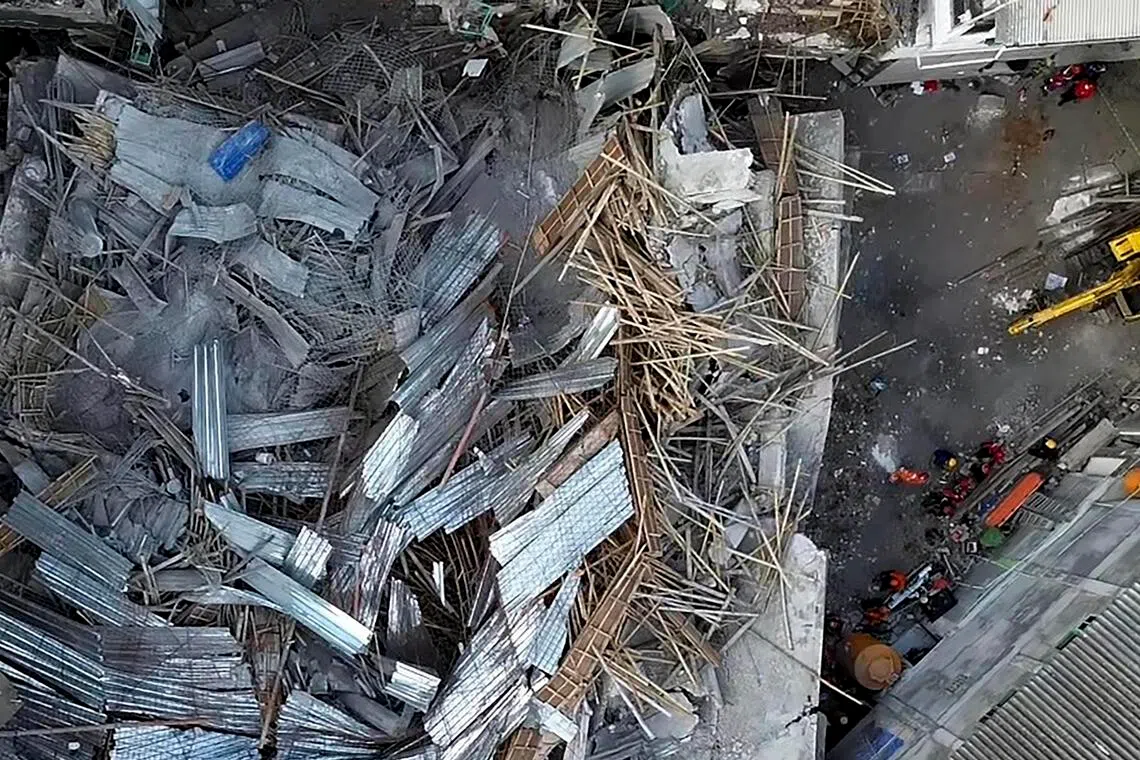No more signs of life in Indonesia school collapse, say rescuers
Sign up now: Get ST's newsletters delivered to your inbox

An aerial view shows the collapsed building at an Islamic boarding school in Sidoarjo, East Java, in Indonesia on Oct 1.
PHOTO: EPA
Follow topic:
SIDOARJO, Indonesia – Rescuers detected “no more signs of life” at a collapsed Indonesian school where 59 people were still believed missing days after the incident, an official said on Oct 2, raising fears that no more survivors would be found.
Part of the multi-storey boarding school on the main island of Java suddenly collapsed on Sept 29,
Five people have since been confirmed dead and 59 people were still feared buried under the rubble after days of rescue operations.
“We used high-tech equipment like thermal drones and, scientifically, there were no more signs of life,” said Mr Suharyanto, the head of the country’s disaster mitigation agency.
Distraught and tearful families waited anxiously near the site for news of their loved ones.
Many burst into tears upon hearing there were no signs of life, and one woman fainted, AFP journalists saw.
Residents near the school opened their homes to families as they waited, while charities set up posts offering food and drink.
“I’ve been here since day one. I am hoping for the best news, that my brother survives. I am still hopeful,” said Ms Maulana Bayu Rizky Pratama, whose 17-year-old brother is missing.
“It’s been four days, I hope my brother will be found soon. I feel sad thinking of him being down there for four days,” the 28-year-old said.
Ms Dewi Sulistiana, whose 14-year-old son is missing, said the authorities had taken a DNA sample from her.
“I want him found so we can bring him home and bury him,” she said through tears.
Rescuers pulled five survivors from the rubble on Oct 1 as frantic parents demanded stronger efforts to find dozens of children believed to still be trapped.
Mr Abdul Hanan, whose 14-year-old son is missing, said children under the rubble had been crying for help.
“The rescue operation must be accelerated,” he urged.
Mr Suharyanto, who, like many Indonesians, uses only one name, hoped that not all of the missing were trapped under the rubble, citing a case where a woman mourned her son only to discover later that he was alive.
Investigations into the cause of the collapse in the town of Sidoarjo are continuing, but initial signs pointed to sub-standard construction, experts said.
Complex operation
The rescue operation is complex as vibrations happening in one place can impact other areas, said Mr Mohammad Syafii, head of the National Search and Rescue Agency.
“So now, to reach the spot where the victims are, we have to dig an underground tunnel,” he told reporters.
Any tunnel will only provide an access route around 60cm wide, because of the structure’s concrete columns.
The families of the missing agreed on Oct 2 for heavy equipment to be used, said Mr Pratikno, Indonesia’s coordinating minister for human development and cultural affairs, who added that rescuers would exercise “extreme caution”.
One crane was already working to clear the rubble, and four more were expected to be deployed to speed up recovery efforts as the 72-hour “golden period” for the best chance of survival came to an end.
However, the operation could last longer than seven days if people are still missing, a search and rescue agency official told AFP.
Families have been able to follow the search and clearing work live on a television screen set up near the site.
The school collapse was so violent it sent tremors across the neighbourhood, said resident Ms Ani.
“I felt a vibration, and then I heard a noise. I immediately ran to save myself. I didn’t realise at first it was a building collapse,” the grocery stall owner told AFP.
The operation was complicated by an earthquake, which struck offshore overnight on Sept 30, briefly halting the search.
The building collapsed after its foundation pillars failed to support the weight of new construction on the fourth floor of the school, the national disaster management agency spokesman said.
Lax construction standards have raised widespread concerns about building safety in Indonesia, where it is common for structures – particularly houses – to be left partially completed, allowing owners to add extra floors later when their budgets permit.
At least three people were killed and dozens injured in September when a building collapsed in West Java province during a prayer recital. AFP

